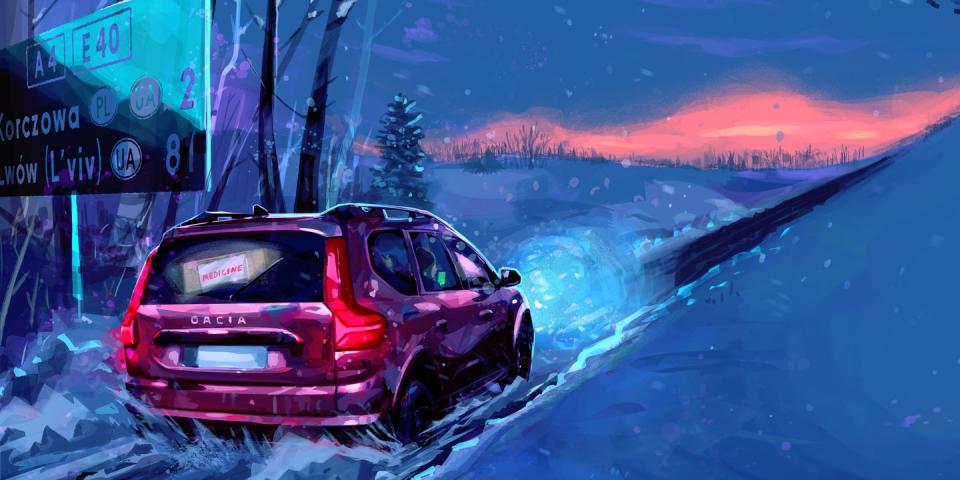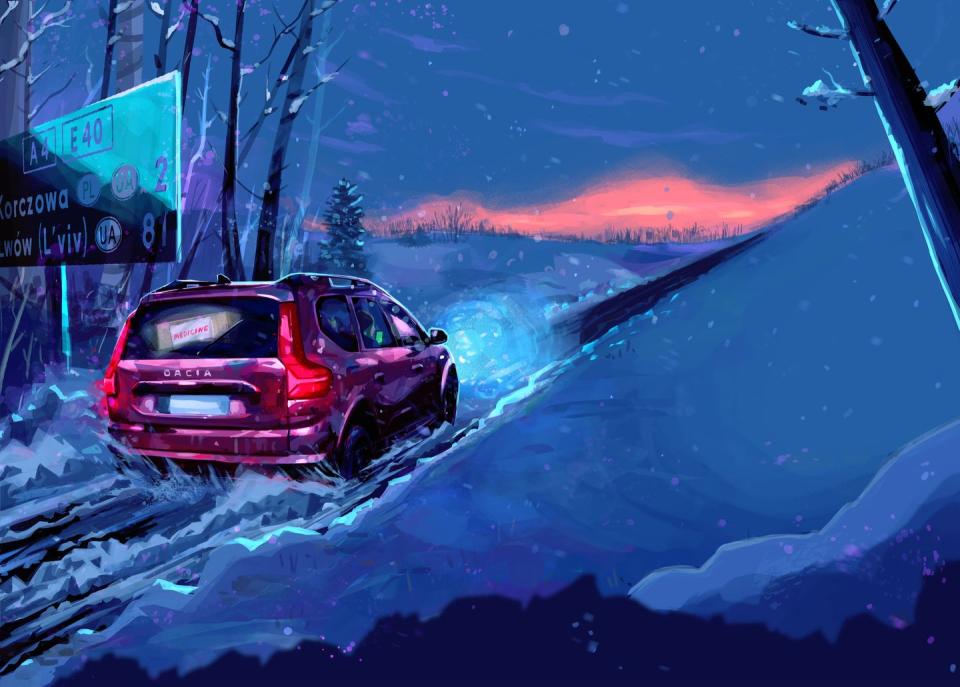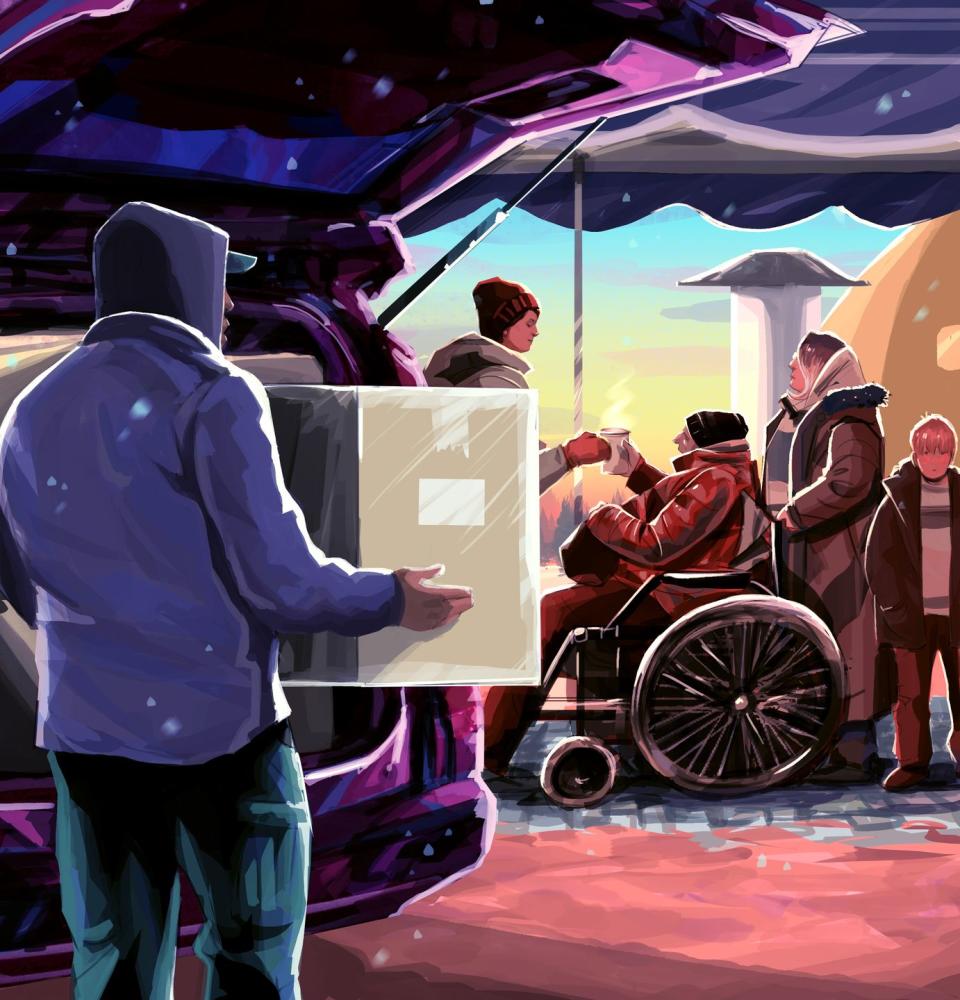I Delivered Ukraine Aid Supplies on One Very Long Night in One Very Ordinary Dacia Minivan


From the July/August 2022 issue of Car and Driver.
The view out my eighth-floor hotel window in Warsaw hit the Cold War kid in me. Barren trees lining the empty street, yellow sodium lights and LEDs illuminating the early-spring snow—it looked like something out of a spy film. I was there waiting for a phone call that would be my signal to drive boxes of mysterious goods into a country at war. I could almost feel the ghost of Robert Ludlum.
I wasn't supposed to be in Poland; I was supposed to be on vacation in Provincetown, Massachusetts. But en route, I was diverted by a text from my friend Krista Barnes, who asked: "Can you go to Poland for three days to drop donations, all paid?"
That unusual message makes a bit more sense if you know that Krista runs a humanitarian nonprofit. The Reel Project's work typically concentrates on eastern Africa, but the Russian invasion of Ukraine found her partnering with Ukraine United Association, run by Nick Zaiets, a Ukrainian in L.A., and Fly for Good, a group specializing in booking inexpensive airfares for humanitarian missions.
Which is how I found myself at the KLM counter at LAX on a Friday in April, checking in for a flight to Warsaw. I'd be playing Krista's wingman, helping her deliver donations to Ukrainian refugees.
I'd intended to look through all the supplies I'd be carrying to ensure that I wouldn't be starring in an episode of Locked Up Abroad, but the Ukrainian chap standing next to a baggage cart had already shrink-wrapped the numerous boxes and suitcases. He said three things to me: "How many boxes can you take?" Followed by, "Each box is about 22 or 23 kilograms." Then, when it was clear that we could take the whole cart, "I'll get more boxes." He did, then disappeared.

In total, we checked six large boxes and three suitcases of goods that I was told would be distributed to shelters around the Polish capital. I'd asked Dacia to borrow a suitable vehicle for making our rounds. Renault's Romanian subbrand came through with a Jogger, a bargain-priced MPV—think minivan with hinged second-row doors—that joined the lineup last year.
Late Saturday afternoon, we landed at the Warsaw airport. We met up with Nick and Dmytro Evseenko, a truck driver in L.A. who parked the rig when the war began and traveled to his hometown in western Ukraine to help locals reach safety in Moldova.
Nick began a flurry of calls to arrange the evening's deliveries. Between calls, he asked me, "Can you drive a manual?" I said yes. "Would you drive a car to Ukraine?" I said yes. He made another call. There'd be no casual gift giving around Warsaw.
Instead, we were to drive Nick's loaded Volkswagen van, platooning to Lviv, Ukraine, with Nick and Dmytro in two other vehicles. But loaded with our 500 pounds of goods, the VW wasn't up for the adventure. An engine mount broke, a condition that made engaging a gear impossible. Three of us pushed the van out. Krista and I Ubered across Warsaw to collect the Jogger and returned to the airport to retrieve the cargo from the broken VW. Before Krista and I departed for our hotel, Nick said, "I'll call you tonight. Be ready around 11:30."
By the time we checked in, showered, and ate, it was too late to consider sleeping.
Rendezvous before Dawn
At 2:30 a.m. Sunday, the phone rang. Krista and I were to meet Nick at a service station in Mroków, about an hour southeast, to hand over the goods in the Jogger. We traveled big empty highways and then narrow rural roads for a few miles before the meeting point. The address gave our American Google indigestion, with Google Maps instructing us at one point to make a right turn into a field of undisturbed snow. The cold felt colder.
Around 4 a.m., we finally found the service station. Soon Nick and Dmytro arrived in two vans with a new plan. They'd split up, and we'd meet up with them again at another location an hour away and do the handoff. I bought way too many gas-station snacks. Krista and I headed out.
Lexico defines "haunting" as "poignant and evocative; difficult to ignore or forget."
Those stressful overnight hours to the next rendezvous were haunting. I was 6000 miles from L.A., taking waypoints from a stranger, and connecting them with a borrowed minivan, its cargo area packed with caboodle. Clouds above, snow below; hazy gray luminescence between shrouding villages and homesteads, churches, skeletal trees, and vacant fields. I convinced myself this was just another road trip.
We reached the Orlen service station in Lubycza Królewska in the first hours of an overcast morning. Krista bought a cup of coffee, and Nick called with yet another plan. We'd need to meet him at another station about 90 minutes away. Back in the Jogger.
Around 8:30 a.m., we pulled into the Lotos station in Skołoszów, and moments later, Dmytro and Nick materialized. We transferred everything except a box marked "Medicine" from the Jogger to a Škoda and a Ford Transit.
We drove the last box 40 minutes to Medyka, where nonprofits from around the world had set up a tent village for refugees, providing hot meals and even SIM cards. We got a tour from Anna, a woman with World Central Kitchen, an organization founded by celebrity chef José Andrés. A steady trickle of Ukrainians entered the encampment, following the stone path to a pickup point where a bus would take them on to a processing center.

 Yahoo Autos
Yahoo Autos 